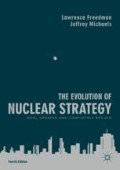Abstract
Nuclear strategy was the product of two lines of scientific and technological development, both of which can be traced back at least to the start of the twentieth century. The first, which began with the study of radioactivity, concerned the structure of the atom and the amounts of energy that might be released if the circumstances in which atoms broke up could be better understood. The second was the possibility of heavier than air flying machines which had been discussed during the previous century as a possibility and became a reality in 1903 when the Wright brothers completed the first manned flight at Kitty Hawk, North Carolina.
Access this chapter
Tax calculation will be finalised at checkout
Purchases are for personal use only
Notes
- 1.
H. G. Wells, The War in the Air (London: George Bell & Sons, 1908); The World Set Free (London: Macmillan, 1914).
- 2.
Harold Nicolson, Public Faces (Bath, Cedric Chivers Ltd., 1968). On the role of Heard, see the Introduction to this edition written by Nigel Nicolson.
- 3.
For a discussion of this literature, see: H. Bruce Franklin, War Stars: The Superweapon and the American Imagination (New York: Oxford University Press, 1988), pp. 131–48 and Merritt Abrash, ‘Through Logic to Apocalypse: Science-Fiction Scenarios of Nuclear Deterrence Breakdown’, Science Fiction Studies, Vol. 13, No. 2, Nuclear War and Science Fiction (Jul., 1986), pp. 129–38.
- 4.
On Szilard and Nicolson, see: Alvin M. Weinberg, ‘The sanctification of Hiroshima’, Bulletin of the Atomic Scientists, 41:11, 1985, p. 34 and Interview with Alvin Weinberg, Oak Ridge National Laboratory Oral History project, March 31, 2003. Edward Teller acquired a copy of Nicolson’s book in 1933. See: Edward Teller w/Judith L. Shoolery, Memoirs: A Twentieth-century Journey in Science and Politics (Cambridge, MA: Perseus Publishing, 2001), p. 87.
- 5.
Richard Rhodes. The Making of the Atomic Bomb (New York: Simon & Schuster, 1986), p. 44. On Szilard see William Lanouette, Genius in the Shadows: A Biography of Leo Szilard, the Man Behind the Bomb (Chicago: University of Chicago Press, 1994).
- 6.
The process was described in L. Meitner and O. R. Frisch, ‘Disintegration of Uranium by Neutrons: A New Type of Nuclear Reaction’, Nature. 143: 3615 (1939): pp. 239–40.
- 7.
Thomas Powers, Heisenberg’s War: The Secret History of the German Bomb (New York: De Capo Press, 2000).
- 8.
Graham Farmelo, Churchill’s Bomb: A Hidden History of Science, War and Politics (London: Faber & Faber 2013). Churchill wrote in 1931: ‘There is no question among scientists that this gigantic source of energy exists. What is lacking is the match to set the bonfire alight, or it may be the detonator to cause the dynamite to explode’. ‘Fifty Years Hence’, Strand (December 1931). On the British project see Margaret Gowing, Britain and Atomic Energy, 1939–1945 (London Macmillan, 1964).
- 9.
Jeremy Bernstein, ‘A memorandum that changed the world’, American Journal of Physics, 79: 440 (2011), pp. 440–6.
- 10.
The letter continued: ‘However, such bombs might very well prove to be too heavy for transportation by air.’ Einstein to President Roosevelt, 2 August 1939, http://www.atomicarchive.com/Docs/Begin/Einstein.shtml.
- 11.
Richard G. Hewlett and Oscar Anderson, The New World 1939/46: Vol, I of a history of the ASAEC (Pennsylvania: Pennsylvania University Press, 1962). See also Rhodes, op.cit.
- 12.
Edward Spiers, A History of Chemical and Biological Weapons (London: Reaktion Books, 2010).
- 13.
Hansard, 10 November 1932, cols. 613–8.
- 14.
Azar Gat, Fascist and Liberal Visions of War: Fuller, Liddell Hart, Douhet, and Other Modernists (Oxford; Clarendon Press, 1998). On the origins of the theory see Mark Clodfelter, Beneficial Bombing: The Progressive Foundations of American Air Power 1917–1945 (Lincoln: University of Nebraska Press, 2010); Tami Davis Biddle. Rhetoric and Reality in Air Warfare: The Evolution of British and American Ideas about Strategic Bombing (Princeton: Princeton University Press, 2002).
- 15.
Carter Malkasian, A History of Modern Wars of Attrition (Westport, CT: Praeger, 2002).
- 16.
Quoted in George Quester, Deterrence Before Hiroshima: The Influence of Airpower on Modern Strategy (New York: John Wiley, 1966), p. 52.
- 17.
Giulio Douhet, The Command of the Air, as translated by Dino Ferrari (New York: Coward-McCann Inc., 1942), pp. 220, 202. On Douhet’s influence see Col. Phillip S. Meilinger, “Giulio Douhet and the Origins of Airpower Theory”, in Col Phillip S. Meilinger, ed., The Paths of Heaven: The Evolution of Airpower Theory (Maxwell Air Force Base, Alabama,: Air University Press, 1997).
- 18.
Carl von Clausewitz, On War, trans. Michael Howard and Peter Paret (Princeton: Princeton University Press, 1989).
- 19.
Raymond Recouly, My Conversations with the Marshal (New York: Appleton, 1929), p. 108.
- 20.
Douhet, op. cit, p. 128.
- 21.
Gustave Le Bon, The Crowd: A Study of the Popular Mind (New York: The Macmillan Co., 1896), http://etext.virginia.edu/toc/modeng/public/BonCrow.html.
- 22.
Ibid., p. 58.
- 23.
Quoted in Quester, Deterrence before Hiroshima, p. 56. For the extent of these fears see Brett Holman, The Next War in the Air: Britain’s Fear of the Bomber, 1908–1941 (London: Ashgate, 2014).
- 24.
The efforts to secure formal international agreement on restraint are described by Donald Cameron Watt in ‘Restraints on war in the air before 1945’, in Michael Howard (ed.), Restraints on War: Studies in the limitation of Armed Conflict (London: Oxford University Press, 1979).
- 25.
B. H. Liddell Hart, The Revolution in Warfare (London, Faber & Faber; 1946), p. 31.
- 26.
For a full treatment of the limited results and high costs of the air war, see Richard Overy, The Bombing War: Europe 1939–1945 (London: Allen Lane, 2013).
Author information
Authors and Affiliations
Corresponding author
Copyright information
© 2019 The Author(s)
About this chapter
Cite this chapter
Freedman, L., Michaels, J. (2019). The Arrival of the Bomb. In: The Evolution of Nuclear Strategy. Palgrave Macmillan, London. https://doi.org/10.1057/978-1-137-57350-6_1
Download citation
DOI: https://doi.org/10.1057/978-1-137-57350-6_1
Published:
Publisher Name: Palgrave Macmillan, London
Print ISBN: 978-1-137-57349-0
Online ISBN: 978-1-137-57350-6
eBook Packages: Political Science and International StudiesPolitical Science and International Studies (R0)

